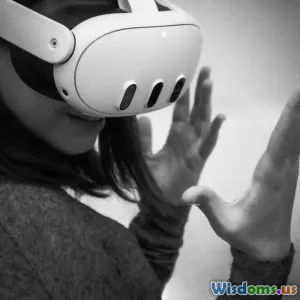
Augmented Reality Is Changing Graphic Design Here’s What to Expect
8 min read Explore how augmented reality is revolutionizing graphic design by merging creativity with immersive technology. (0 Reviews)
Augmented Reality Is Changing Graphic Design: Here’s What to Expect
Introduction
Graphic design has always been at the intersection of creativity and technology, evolving as new tools and innovations have emerged. Today, few technologies promise to reshape graphic design as profoundly as Augmented Reality (AR). AR blends digital elements seamlessly with the real world, paving a creative renaissance that extends far beyond traditional print or screen-based media. But what exactly does this mean for graphic designers and the industry at large? How will AR reshape the way designers conceive, create, and deliver visual content?
In this article, we’ll dive deep into how AR is transforming graphic design, highlighting new opportunities, real-world applications, and what creatives can expect as augmented reality becomes an integral design tool.
The Rise of Augmented Reality in Visual Communication
Augmented Reality enhances our perception by overlaying virtual images, text, or animations atop a physical environment, typically viewed through smartphones, tablets, or AR glasses. Unlike Virtual Reality, which immerses users in a fully digital world, AR enriches the real-life space, making it uniquely powerful for storytelling and engagement.
Recent reports forecast the AR market to be worth over $198 billion by 2025, with the design and advertising sectors as key drivers. This growth signals a major shift in how businesses and creatives approach visual communication. For graphic designers, AR isn’t just an add-on; it’s a whole new canvas with dynamic, interactive capabilities.
How AR is Changing Graphic Design
1. From Static to Interactive Visuals
Traditional graphic design has focused largely on static media—posters, logos, packaging, websites—with limited interaction. AR flips this model by introducing interactivity, responding to the user's environment and actions. For example, 3D models of products can be scanned and rotated in real space, generating a more engaging customer experience.
IKEA’s Place app is a prime example where users can visualize furniture dimensions and style directly in their homes through AR, helping bridge the gap between concept and reality. Designers creating artwork for such applications need to master 3D modeling and user experience principles, expanding beyond conventional 2D graphics.
2. New Skillsets and Tools for Designers
To leverage AR’s full potential, graphic designers are developing new skill sets in 3D modeling, animation, spatial design, and even coding. Tools like Adobe Aero, Unity, and Unreal Engine facilitate AR content creation, enabling designers to prototype and deploy immersive visuals without requiring deep programming knowledge.
This evolution is forcing educational institutions and design studios to rethink curricula and workflows, encouraging multi-disciplinary collaboration between graphic designers, programmers, and UX specialists. Renowned design agencies report that designers comfortable with AR tools see a marked competitive advantage and innovative freedom.
3. Immersive Brand Experiences
AR offers brands the chance to create memorable, immersive experiences that can significantly boost customer engagement. Graphic design involves crafting not just standalone visuals but entire augmented worlds where users interact directly with brand narratives.
Take the example of the Converse “Sampler” campaign, which allowed users to point their phones at shoes and visualize their history and design process in AR. This multi-layered storytelling adds emotional appeal and brand loyalty, fundamentally shifting how visual design supports marketing strategies.
4. Challenges and Ethical Considerations
While AR opens exciting possibilities, it also presents challenges. Designing for diverse devices requires meticulous optimization to prevent lag and discomfort. Moreover, user privacy is a concern as AR often involves data collection about physical environments. Designers and developers must prioritize ethical standards and transparency.
Additionally, accessibility within AR environments remains a developing frontier, as not all audiences have equal access to AR-capable devices, potentially limiting reach.
Future Trends: What to Expect in AR-Driven Graphic Design
Integration with AI for Smarter Design
Artificial Intelligence is increasingly intertwined with AR, helping automate complex animations, personalize content, and predict user behavior. AI-powered tools can assist designers in rapidly iterating concepts or adapting designs for variable real-world contexts.
Cross-Disciplinary Collaboration
Technology is blurring traditional disciplinary lines. Graphic designers will work alongside architects, game developers, marketers, and data scientists to bring AR projects to life. Collaborative platforms and shared skillsets will become the norm.
Expanding Beyond Commercial Use
While currently dominant in advertising and retail, AR graphic design is rapidly entering education, healthcare, and urban planning. For instance, AR overlays can help students learn anatomy or allow doctors to visualize surgical procedures in 3D. Graphic design will thus evolve to accommodate diverse, highly technical storytelling demands.
Designing with Environmental Contexts in Mind
Because AR links digital to physical realities, graphic designers must consider lighting, spatial scale, surface textures, and user movement—all factors nonexistent in traditional design. This requires a shift from flat compositions to spatial narratives, ensuring harmonious digital-real world integration.
Conclusion
Augmented reality is far more than a novel gimmick; it’s a groundbreaking wave reshaping graphic design’s core principles. By moving from static images to interactive, immersive experiences, AR enables designers to craft environments and narratives that captivate audiences like never before.
For designers, embracing AR means acquiring new skills, engaging in cross-disciplinary collaboration, and rethinking communication strategies to harness this technology's full communicative potential. Brands and consumers alike will benefit from richer, more personalized engagement through AR-enhanced visuals.
As AR evolves, it will spur a creative transformation where graphic design plays a pivotal role in bridging the digital and real worlds. Those ready to innovate and adapt stand to redefine visual storytelling for the future.
References
- Statista: Augmented Reality Market Size, 2021-2025
- Adobe Aero Official Website
- IKEA Place App: Enhancing Furniture Shopping with AR
- Converse Sampler Campaign Case Study
- Forbes Insights on AI and AR Collaboration in Design
Embrace the augmented design revolution today and craft the future of immersive visual storytelling.
Rate the Post
User Reviews
Popular Posts





















